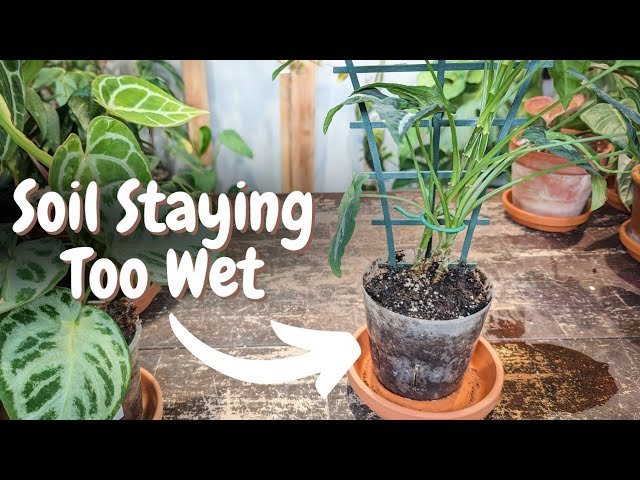

Simple Steps: How To Dry Out Soil For Improved Plant Growth
To dry out soil effectively, a strategic approach is crucial. Excess moisture can hinder plant growth and lead to root rot. A balance is key – not too dry nor too wet. Start by improving drainage, using organic matter to promote aeration. Consider the season and local climate for optimal results. Patience and consistency are crucial in the process of drying out soil. By following these steps, you can achieve the right balance for healthy plant growth.
How to Dry Out Soil: A Complete Guide
Welcome, fellow gardeners and plant enthusiasts! Have you ever faced the challenge of dealing with waterlogged or soggy soil in your garden or pots? Fear not, for in this comprehensive guide, we will explore various effective methods on how to dry out soil and restore the perfect balance for your beloved plants.
The Importance of Well-Drained Soil
Before we delve into the ways to dry out soil, let’s understand why well-drained soil is crucial for the health and growth of plants. Soil that is constantly saturated with water can lead to root rot, oxygen deprivation, and a host of other issues that can harm your plants. Adequate drainage is essential to prevent water from pooling around the roots and causing damage.
Signs of Waterlogged Soil
Identifying waterlogged soil is the first step in rectifying the issue. Common signs include stagnant water on the surface, a foul smell, wilting plants, yellowing leaves, and slow growth. Observing these signs promptly can help you take timely action to save your plants.
Methods to Dry Out Soil
1. Adjusting Watering Practices
One of the simplest ways to dry out soil is by adjusting your watering practices. Overwatering is a common cause of waterlogged soil. Ensure you water your plants only when needed, allowing the top few inches of soil to dry out between waterings. This will help maintain the right moisture level in the soil.
2. Improving Drainage
If your soil tends to retain water, consider improving the drainage in your garden or pots. Adding organic matter such as compost, perlite, or sand can help loosen compacted soil and enhance drainage. You can also create raised beds or use pots with drainage holes to facilitate water flow.
3. Using Mulch
Mulching is a great way to regulate soil moisture and prevent waterlogging. Organic mulches like bark chips or straw can help absorb excess water and reduce evaporation, maintaining a balanced level of moisture in the soil. Apply a layer of mulch around your plants to protect them from waterlogging.
4. Aerating the Soil
Aerating the soil can promote better drainage and prevent waterlogging. Using a garden fork, gently loosen the soil to allow air, water, and nutrients to penetrate deeper. Aeration also helps break up compacted soil, improving root growth and overall plant health.
5. Using Soil Amendments
Soil amendments such as gypsum or agricultural lime can help improve soil structure and drainage. These amendments work by breaking up clay particles and improving water infiltration. Incorporate them into the soil according to package instructions to enhance drainage and prevent waterlogging.
6. Installing a French Drain
If waterlogging is a persistent issue in your garden, consider installing a French drain. A French drain is a trench filled with gravel or rock that redirects excess water away from the soil. This can be an effective long-term solution for areas prone to waterlogging.
7. Using a Wet-Dry Vacuum
In cases of severe waterlogging, you can use a wet-dry vacuum to remove excess water from the soil. Be sure to use the vacuum on the lowest setting to avoid damaging the roots. This method can quickly eliminate standing water and prevent further damage to your plants.
By following these practical methods on how to dry out soil, you can ensure a healthy and thriving environment for your plants. Remember to monitor the moisture levels regularly and make adjustments as needed to prevent waterlogging. With a little care and attention, you can enjoy a lush and vibrant garden free from the woes of waterlogged soil. Happy gardening!
Thank you for reading our guide on how to dry out soil. We hope you found it informative and helpful in your gardening endeavors. Stay tuned for more tips and tricks on plant care and soil management. Remember, a little love and care can go a long way in nurturing your green friends!
How to dry out Wet grounds
Frequently Asked Questions
How can I dry out soil effectively after heavy rainfall?
To dry out soil after heavy rainfall, first, ensure good drainage in the area by adding organic matter like compost to improve soil structure. Additionally, you can use aeration tools to promote air circulation within the soil and speed up the drying process. Avoid overwatering during this time and consider using a tarp to cover the soil to prevent further saturation.
What are some techniques to dry out soil in a garden bed or container?
If you need to dry out soil in a garden bed or container, you can gently loosen the top layer of soil with a fork to improve aeration. Placing the container in a sunny spot can help evaporate excess moisture. Using fans or dehumidifiers near the soil can also aid in drying it out more quickly. Be mindful not to compact the soil further during this process.
Can excessive watering lead to waterlogged soil, and how can I dry it out?
Yes, excessive watering can lead to waterlogged soil, which deprives plant roots of oxygen and can cause wilting or root rot. To dry out waterlogged soil, you can create drainage channels, mix in sand or perlite for better drainage, and avoid watering until the soil has dried out to the desired level. Elevating containers and adjusting watering practices can prevent future waterlogging issues.
Final Thoughts
In conclusion, effectively drying out soil involves proper drainage, sunlight exposure, and aeration. Avoid overwatering and consider using organic matter to improve soil structure. Remember to test the soil moisture levels regularly to prevent issues with waterlogging. Following these steps will help you successfully dry out soil and create a healthy environment for your plants to thrive.


